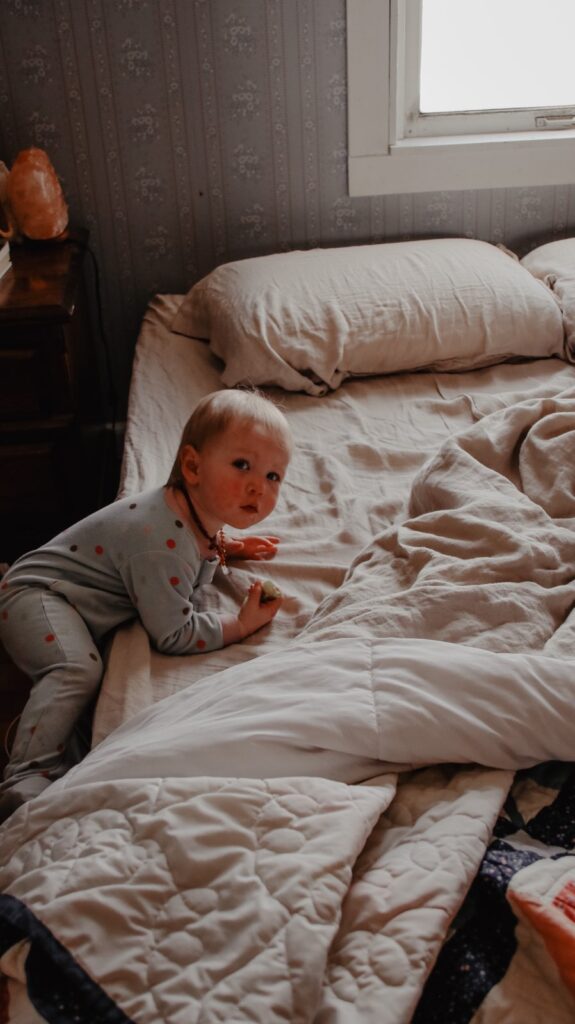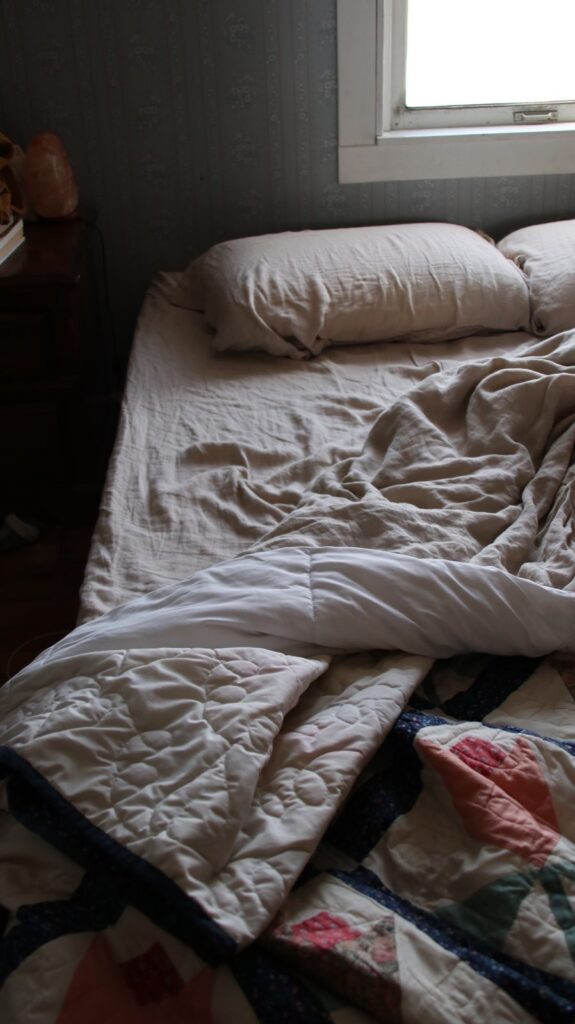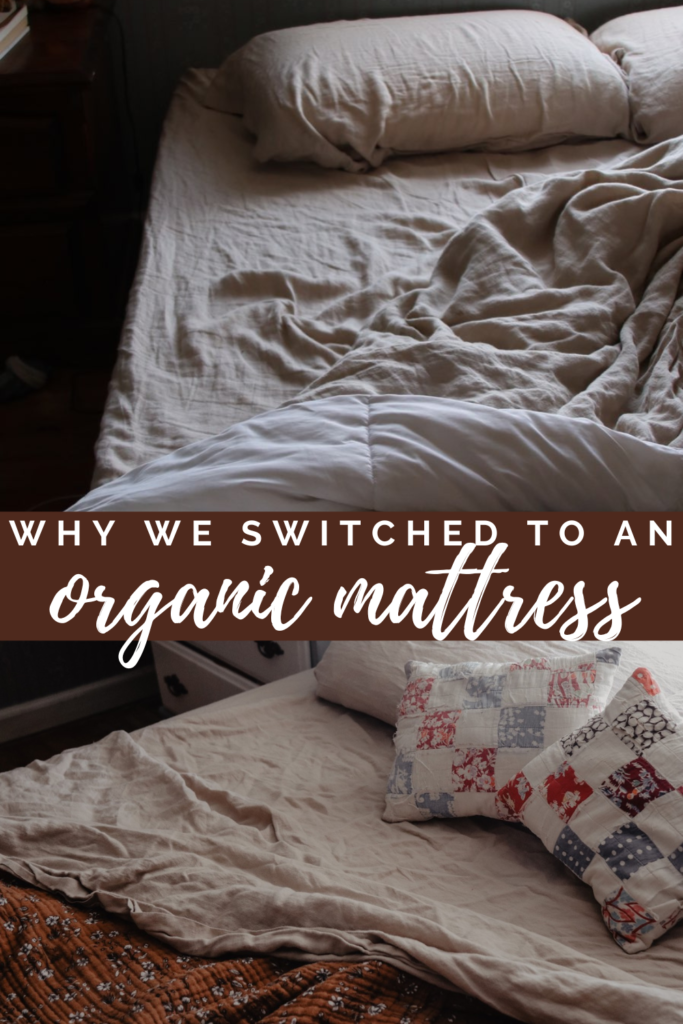Why We Use An Organic Mattress, and why conventional mattresses are quite dangerous and toxic! We need to prioritize quality with our sleep!
This post may contain affiliate links. Read my disclosure policy here.
We recently made the switch to an organic mattress and finally got rid of our conventional toxic one!
I was so happy to see that old thing go! This has been on my list to switch over for years now.
And let me tell y’all, I can never go back.
The difference in how I sleep now is undeniable.
We spend about 1/3 of our lives sleeping in our beds. Since we spend so much time in bed, they can have a huge affect on our health. Quality really matters when it comes to sleep.
To spend six to nine hours every night with your face and body pressed into a chemical-filled surface, breathing in and absorbing harmful substances, is extremely dangerous. It is even more frightening when you realize that children are even more susceptible to toxins, and this could be affecting their long-term health as they go through vital development and growth processes.
Non-organic mattresses may seem to be a safe enough option, and for some it may not seem worth it to spend so much more on the price tag for an organic option. But upon further examination, I don’t think it’s worth it to risk exposure to harmful chemicals and electromagnetic radiation.

So what are the reasons you should consider switching as well?
Non-organic mattresses are full of toxic chemicals
A lot of mattresses on the market today use polyurethane foam (polyfoam) as the fill-in material. That’s because…you guessed it! Polyfoam is cheap to make! That’s usually why some material is used, it’s cheap for the manufacturer so they get more profit, at our expense. Polyfoam is widely produced and has been a leading mattress material since the 1960s. This foam is made using petroleum, though, which means highly toxic chemicals usually including:
- Propylene oxide
- Toluene diisocyanate (TDI)
- Benzene
- Dimethylformamide (DMF)
- Polyols
But polyfoam isn’t the only toxic material introduced in mattresses, unfortunately. A lot of them may also incorporate vinyl to reduce fluid absorption. This is especially common with crib mattresses, which is just heartbreaking, because babies are the more susceptible to health problems from a toxic load because of their fragile immune systems and still-developing bodies. Vinyl is another petroleum-based product, which (again) means harmful chemicals are used in its production and it usually contains Phthalates and Antimony & other heavy metals
As an alternative to polyfoam, some manufacturers use latex. While natural latex is safe, synthetic latex means more mattress chemicals. The mattress we switched to is natural latex, they use natural rubber from organic farmers in Sri Lanka. So when considering latex, make double sure it is from a natural organic source.
A lot of non-organic mattresses have toxic flame retardants
To meet the flame retardancy requirements, manufacturers will often take shortcuts and add chemicals like polybrominated diphenyl ether, which is also known as PBDE. Not only that, but they do not need to disclose this information to consumers, even though PBDE has has been banned in Europe, Canada, and several states in the US. Polybrominated diphenyl ether has been shown to build up in the human body over time and it does not lessen or leave the body after the exposure has stopped. You should be extremely concerned about this chemical exposure because of the significant health side effects associated with polybrominated diphenyl ether:
- Decreased sperm count
- Thyroid problems
- Brain damage
- Reproductive damage
- Cancer (in cases of prolonged, high levels of exposure)
Non-organic mattresses can have toxic chemical off-gassing
Have you ever noticed a chemical smell coming from your mattress, especially if it’s brand new? Chemical off-gassing occurs when an item releases volatile organic compounds (VOCs) into the air. VOCs have the ability to vaporize, or off-gas, at room temperature. The process of vaporizing leads to those chemicals lingering in the air, where they can be inhaled and potentially cause short and long-term health problems.
So even though after awhile you may not notice the smell from your new mattress anymore, and all the immediate symptoms (like headaches, allergic reactions, dizziness, nausea, etc) may have passed, they can still cause long-term health issues. Meaning, they aren’t to be taken lightly.
The issue of EMFs
EMFs can are very damaging to human cells, and that is especially true when we are sleeping. They can also lower melatonin production and disrupt our circadian rhythm, which are both crucial to getting a good night’s sleep. When we sleep our bodies of “off duty” in a way which makes us more susceptible to harm from electrical radiation. This is why we are sure to turn our WiFi router off each and every night, but I leave it on during the day. I like to give our bodies a break and time to heal and regenerate at night.
Mattresses with springs or coils inside can actually amplify EMFs. They act as a sort of antenna.
This is why it’s a good idea to go with an organic latex mattress, those don’t need springs inside because the latex is naturally springy.

Non-organic mattresses create a lot of waste
As with most conventional non-organic items, the manufacturing process creates a lot of waste. They are always more concerned with their bottom line than being good stewards of the earth that God gave us. Not only does this apply to creating harmful toxins, but wasting the resources we have been given and filling the earth with plastic and trash.
On the other hand, when buying an organic latex mattress, the process is so much more sustainable and zero-waste. This is from Earth Foam’s website:
Rubber tree forests are beautiful and highly sustainable. One tree can supply sap (liquid latex) for over 20 years and rubber trees have one of the highest carbon dioxide absorption rates. When we first started sourcing it, the rubber industry in Sri Lanka was dying. It was hard for farmers to compete with cheaper crops, even if they weren’t good for the land or the local economy.
Natural foam rubber is pretty amazing, really. Take milky sap from a rubber tree, spin it really fast to get the water out, mix it with small amounts of compounds to help the molecules bind together, pour it into a mold, bake it at 212 degrees for an hour, and ta-da: you have a squishy white square you can sleep on.
Natural rubber is literally just from trees! And if one tree can live for 20 years, imagine the potential in a forest of rubber trees, being tapped every year. It’s not destroying the forest, it’s properly managing it’s resources. So much better than trying to use vinyl or petroleum to make a mattress.
So how can you tell if a mattress is safe?
One great way to tell if the mattress you’re considering buying is safe, is if they are certified with the Global Organic Textile Standard (GOTS). That ensures that the mattress is made of 95 percent organic material. Also that no chemical flame retardants or polyurethane was used in its manufacture.
For latex mattresses, the Global Organic Latex Standard (GOLS). This ensures that the latex used is 95 percent organic and that no chemical flame retardants or polyurethane was used.
The new mattress we have from Earth Foam has both of these certifications.
Those are the reasons we decided it was best for our family to slowly switch over to organic mattresses as the budget allows!
And blessings!
Pin it for later!


Do you still like this mattress? I am considering one and was wondering if you still found it a good one after some time. Thanks.